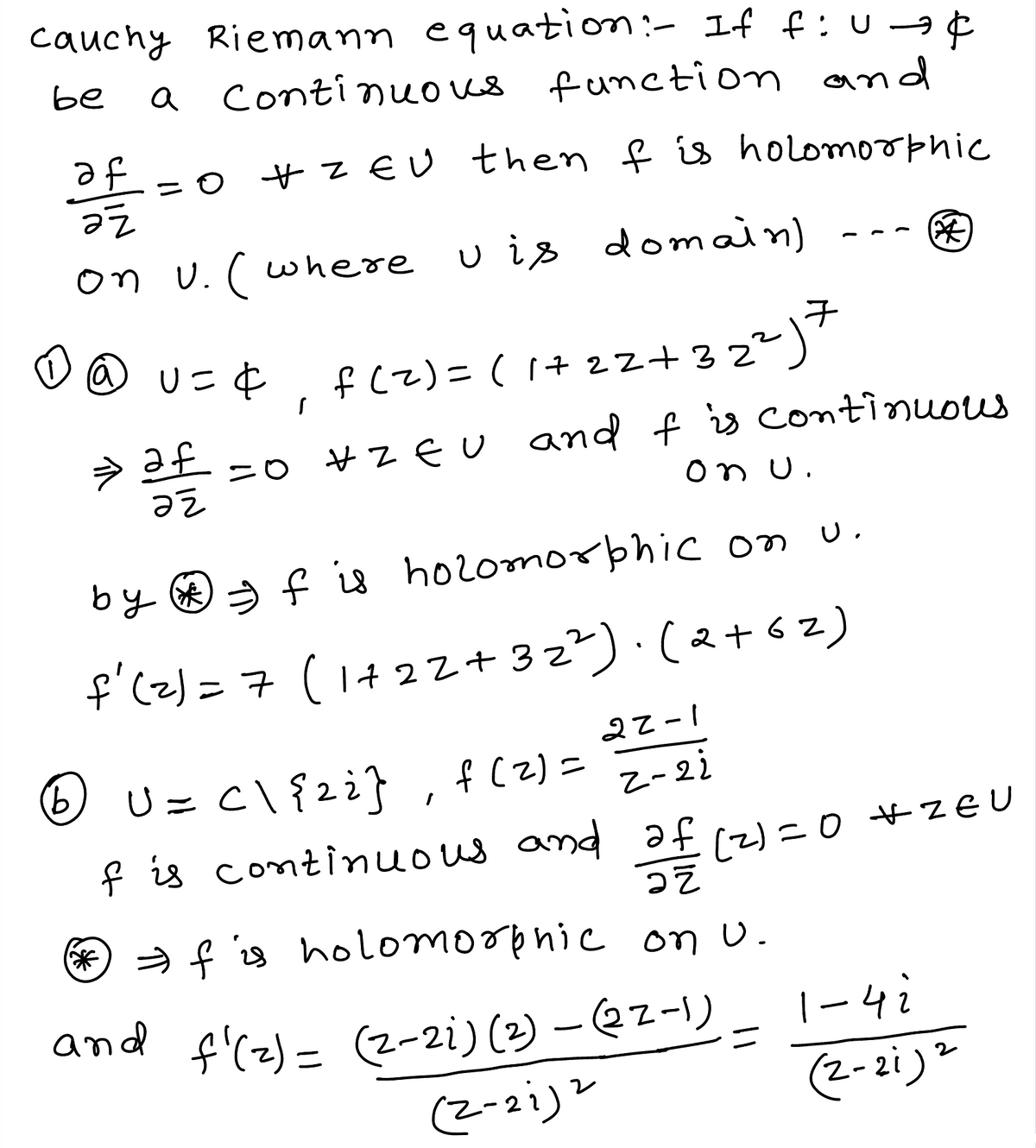Show the following functions are holomorphic on the domains given, and compute their derivative f'(z): (a) U = C, f(z) = (1+2z+32²)7. (b) U = C\ {2i}, f(z) = 21 (c) U = C\ {i, -i}, ƒ(z) = (¹–2²¹. (d) U = {z € C: cos(z) 0} and f(z) =tan(z) where tan(z) is defined to be (e) U = C and f(z) = cosh(z) where cosh(z) is defined as cos(iz). sin(z) COR(2)
Show the following functions are holomorphic on the domains given, and compute their derivative f'(z): (a) U = C, f(z) = (1+2z+32²)7. (b) U = C\ {2i}, f(z) = 21 (c) U = C\ {i, -i}, ƒ(z) = (¹–2²¹. (d) U = {z € C: cos(z) 0} and f(z) =tan(z) where tan(z) is defined to be (e) U = C and f(z) = cosh(z) where cosh(z) is defined as cos(iz). sin(z) COR(2)
Advanced Engineering Mathematics
10th Edition
ISBN:9780470458365
Author:Erwin Kreyszig
Publisher:Erwin Kreyszig
Chapter2: Second-order Linear Odes
Section: Chapter Questions
Problem 1RQ
Related questions
Question
q1
![1. Show the following functions are holomorphic on the domains given, and compute their derivatives \( f'(z) \):
(a) \( U = \mathbb{C} \), \( f(z) = (1 + 2z + 3z^2)^7 \).
(b) \( U = \mathbb{C} \setminus \{2i\} \), \( f(z) = \frac{2z - 1}{z - 2i} \).
(c) \( U = \mathbb{C} \setminus \{i, -i\} \), \( f(z) = \left( \frac{1 - z^2}{1 + z^2} \right)^4 \).
(d) \( U = \{ z \in \mathbb{C} : \cos(z) \neq 0 \} \) and \( f(z) = \tan(z) \) where \( \tan(z) \) is defined to be \( \frac{\sin(z)}{\cos(z)} \).
(e) \( U = \mathbb{C} \) and \( f(z) = \cosh(z) \) where \(\cosh(z)\) is defined as \(\cos(iz)\).
[Hint: You should be able to do most of these using Proposition 2.7.7.]](/v2/_next/image?url=https%3A%2F%2Fcontent.bartleby.com%2Fqna-images%2Fquestion%2F27adff13-7954-4bd1-a3e1-459b28324214%2F9e13b7b0-c345-4b3c-a11e-936af09cd016%2Fkx4z7q6_processed.png&w=3840&q=75)
Transcribed Image Text:1. Show the following functions are holomorphic on the domains given, and compute their derivatives \( f'(z) \):
(a) \( U = \mathbb{C} \), \( f(z) = (1 + 2z + 3z^2)^7 \).
(b) \( U = \mathbb{C} \setminus \{2i\} \), \( f(z) = \frac{2z - 1}{z - 2i} \).
(c) \( U = \mathbb{C} \setminus \{i, -i\} \), \( f(z) = \left( \frac{1 - z^2}{1 + z^2} \right)^4 \).
(d) \( U = \{ z \in \mathbb{C} : \cos(z) \neq 0 \} \) and \( f(z) = \tan(z) \) where \( \tan(z) \) is defined to be \( \frac{\sin(z)}{\cos(z)} \).
(e) \( U = \mathbb{C} \) and \( f(z) = \cosh(z) \) where \(\cosh(z)\) is defined as \(\cos(iz)\).
[Hint: You should be able to do most of these using Proposition 2.7.7.]
Expert Solution
Step 1

Step by step
Solved in 2 steps with 2 images

Recommended textbooks for you

Advanced Engineering Mathematics
Advanced Math
ISBN:
9780470458365
Author:
Erwin Kreyszig
Publisher:
Wiley, John & Sons, Incorporated

Numerical Methods for Engineers
Advanced Math
ISBN:
9780073397924
Author:
Steven C. Chapra Dr., Raymond P. Canale
Publisher:
McGraw-Hill Education

Introductory Mathematics for Engineering Applicat…
Advanced Math
ISBN:
9781118141809
Author:
Nathan Klingbeil
Publisher:
WILEY

Advanced Engineering Mathematics
Advanced Math
ISBN:
9780470458365
Author:
Erwin Kreyszig
Publisher:
Wiley, John & Sons, Incorporated

Numerical Methods for Engineers
Advanced Math
ISBN:
9780073397924
Author:
Steven C. Chapra Dr., Raymond P. Canale
Publisher:
McGraw-Hill Education

Introductory Mathematics for Engineering Applicat…
Advanced Math
ISBN:
9781118141809
Author:
Nathan Klingbeil
Publisher:
WILEY

Mathematics For Machine Technology
Advanced Math
ISBN:
9781337798310
Author:
Peterson, John.
Publisher:
Cengage Learning,

